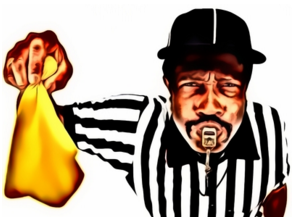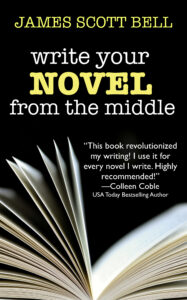by James Scott Bell
@jamesscottbell
 The Fugitive (1993) is one of my all-time favorite thrillers, both to watch and to teach. So many great lessons can be drawn from it. I’ll share a few with you today.
The Fugitive (1993) is one of my all-time favorite thrillers, both to watch and to teach. So many great lessons can be drawn from it. I’ll share a few with you today.
Based on the hit TV show from the 1960s, it’s the story of respected surgeon Dr. Richard Kimble (Harrison Ford), who comes home one night to find his wife dying at the hands (or rather, hand) of a one-armed man. Kimble fights with him, but the man gets away. Kimble tries to save his wife, to no avail. He is convicted of first-degree murder and sentenced to death. He escapes. A crack team led by Deputy U.S. Marshal Sam Gerard (Tommy Lee Jones) sets out to track him down.
 The story question: Can Kimble keep ahead of the law long enough to prove his innocence by finding the one-armed man?
The story question: Can Kimble keep ahead of the law long enough to prove his innocence by finding the one-armed man?
Structure
At a little over two hours, the movie is a terrific study in the power of structure. The film would not be nearly as engaging if it did not hit the right signposts at the right time.
Thus, we get the opening disturbance in the very first shot: a TV reporter stands outside the Kimble home, where the police are investigating the death of Kimble’s wife. Kimble is taken to the police station and questioned by two detectives. He thinks it’s as a grieving husband, but soon it dawns on him that they consider him the chief suspect.
Yeah, I’d be disturbed, too.
Lesson: Start your story by striking a match, not by laying out the wood. (h/t John le Carré.) You have plenty of time for backstory later. Readers will happily wait for fill-in material if they’re caught up in immediate trouble.
On we go through Act 1: Kimble is convicted, sentenced, put on a prison bus. A couple of convicts stage an uprising, the driver is shot, a guard is stabbed, the bus tumbles off the road and onto railroad tracks…just as a train comes right for it!
This is one great action sequence. The convicts and one guard get the heck out of the bus. But Kimble stays behind to help the wounded guard, gets him out a window, and jumps one second before the train hits the bus. That would be enough for most writers, but not for screenwriters Jeb Stuart and David Twohy. Half the derailed train breaks off and comes right at the fleeing Kimble! He barely avoids being crushed.
Lesson: When you have a great action sequence, or suspenseful scene, stretch the tension as far as you can. Ask: What else could go wrong? What could make things worse?
At the crash site, while local law enforcement is botching things, Deputy U.S. Marshal Sam Gerard arrives with his crack team. He figures out what’s going on, orders roadblocks, and announces, “Your fugitive’s name is Dr. Richard Kimble. Go get him.”
Boom! We are ¼ of the way into the film, and the Doorway of No Return has just slammed shut. Kimble cannot go back to his ordinary life. He must face the “dark forest” (almost literally) at the heart of myth. Survive or be killed.
Lesson: In a novel, my view is that the Doorway should happen no later than the 1/5 mark. Otherwise, things start to drag.
Solid structure is a beautiful thing. Far from being a hindrance, it is the most powerful way to share the story in your head and heart with an audience. See: “Story and Structure in Love.”
The Mirror Moment
Act 2, of course, is a series of rising action, mostly of Kimble barely keeping escaping his pursuers. At the exact halfway point, where we would expect to find it, is the Mirror Moment.
(If this term is unfamiliar to you, I’ve written a book about it. But lest you think I’m only interested in money (I am interested in it, just not only interested in it) you can check out a couple of TKZ posts here and here.)
As I explain in my book, there are two types of mirror moments: 1. The character looks at himself and asks questions like, “Who am I? What have I become? Am I going to stay this way?” It’s an internal gaze. 2. The character looks at his situation and thinks, “I’m probably going to die. There’s no way I can survive this.” This is an external look.
The second kind is what we have in The Fugitive. In the middle of the film Kimble has rented a basement room from a Polish woman. He’s using it as a base of operations to sneak into Cook County hospital. He wants to access the records of the prosthetics wing to get a list of patients with artificial arms.
In the mirror scene, Kimble is awaked from slumber by the sound of police swarming the house. Kimble looks for a way to escape, but there is none. He’s done for!
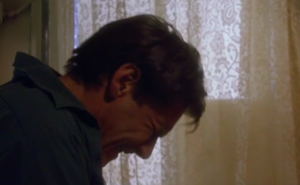 Only it turns out the cops are there to nab the Polish woman’s drug-dealing son.
Only it turns out the cops are there to nab the Polish woman’s drug-dealing son.
As the police lead him away, Kimble has a small breakdown. He’s thinking, “I can’t possibly win against these odds. I’m as good as dead.”
Lesson: No matter how you write, via outline, winging it, or something in between, take some time early in the process to brainstorm possible mirror moments, of both varieties. Push yourself past the familiar. Inevitably, one of them will feel just right. It will become your guiding light for the entire novel.
To get us into Act 3, we need a Second Doorway. This is either a setback or crisis, or major clue/discovery. It should happen by the ¾ mark, and in The Fugitive it does. I won’t give the spoiler here, but suffice to say it’s the major clue implicating the villain. Now the Final Battle becomes inevitable.
Pet the Dog
This is such a great way to increase the audience bond with the hero. It’s a scene or sequence in Act 2 where the hero takes time to help someone more vulnerable than he, even at the cost of making his situation worse. The Fugitive has one of the best examples you’ll ever see.
Kimble is disguised as a hospital custodian. He’s accessed the prosthetics records he needed. As he’s leaving he walks along the trauma floor. All sorts of triage patients being tended to. He notices a little boy groaning on a gurney. A doctor orders a nurse to check on the boy. The nurse gives him a cursory look. Kimble is aghast. He knows there’s something wrong here.
 The doctor reappears and asks Kimble to help out by taking the boy to an observation room. Kimble wheels him away, checking out the X-ray as he goes. He asks the lad a few questions about where it hurts, then changes the orders and gets the boy to an operating room for immediate attention.
The doctor reappears and asks Kimble to help out by taking the boy to an observation room. Kimble wheels him away, checking out the X-ray as he goes. He asks the lad a few questions about where it hurts, then changes the orders and gets the boy to an operating room for immediate attention.
That’s a success, but in a thriller any success should be followed by some worse trouble.
Turns out the doctor saw Kimble look at the film, and confronts him as he’s walking out. She rips off his fake ID and calls for security. More trouble! (This sequence has a favorite little moment. As Kimble is rushing down the stairs to get away, he brushes past someone coming up. He looks back and says, “Excuse me.” Kimble is so fundamentally decent he apologizes even as he’s running for his life!)
Lesson: Create a character the hero can help, even in the midst of all his troubles (e.g., Rue in The Hunger Games). The deepening bond this creates with the reader is so worth it.
Character
The Fugitive features a protagonist and antagonist who are both sympathetic. Kimble, of course, is a devoted husband wrongly convicted of murder. Sam Gerard is a great lawman who doggedly pursues justice.
Lesson: You don’t need a traditional villain to carry your thriller. In The Fugitive, it’s two good men with agendas in direct conflict. The true villain reveal is at the end.
Dialogue
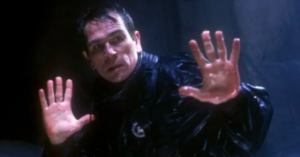 Many of the great lines in the movie were actually improvised. The most famous is from the spillway scene. Kimble has a gun on Gerard. Kimble says, “I didn’t kill my wife!” And Gerard says, “I don’t care!” Tommy Lee Jones came up with that.
Many of the great lines in the movie were actually improvised. The most famous is from the spillway scene. Kimble has a gun on Gerard. Kimble says, “I didn’t kill my wife!” And Gerard says, “I don’t care!” Tommy Lee Jones came up with that.
Another perfect line not in the script is just after the train derailment. Another prisoner, Copeland, a stone-cold killer, helps Kimble to his feet. He says to Kimble, “Now you listen. I don’t give a damn which way you go. Just don’t follow me. You got that?”
As he’s pulling away Kimble says, “Hey Copeland.” Copeland turns around. Kimble says, “Be good.” Another mark of his decency, like when he said, “Excuse me.”
Love it! You can get a bestselling book on the subject, but the gist is simple:
Lesson: Great dialogue is the fastest way to improve any manuscript.
Over to you for discussion. And as a bonus for reading all the way to the end of this lengthy post, let me mention that Romeo’s Way, the novel that won the International Thriller Writers Award, is FREE, today only. Grab it here.

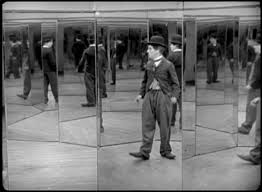 Once you wrap your head around the concept of the
Once you wrap your head around the concept of the  Half my life’s in books, written pages.
Half my life’s in books, written pages.


